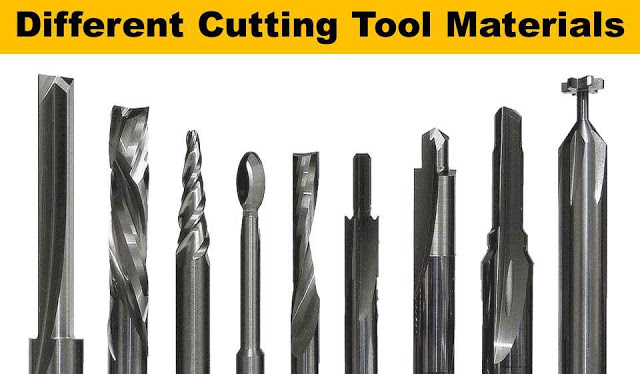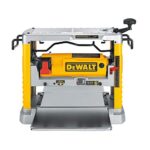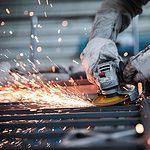Today we will discuss about most common cutting tool materials used in mechanical industries. Tool play very important role in machining. The shape of work piece, its surface finish and some other properties are directly dependable on the tool material and its design. A proper designed tool with appropriate material gives better surface finish and high accuracy. Most important characteristic of tool are:
- It should have high hot hardness.
- High Wear Resistance.
- Tool should have high Toughness and hardness.
- It should have high thermal conductivity.
- Tool works at high temperature during cutting so it should
have low coefficient of thermal expansion. - Tool should have high strength.
- It should have Low coefficient of friction and should be chemically stable.
Cutting Tool Materials:
Most common engineering materials used in tool making are:
Carbon Steel Tool:
Carbon Steel is widely used for machining soft materials like, Magnesium, Aluminum, Wood etc. It contains carbon, silicon and magnesium as its constitute. This material used for making hand drills narrow blade, taps, dies, chisels etc. Its cutting speed is about 10 mm and highest temperature up to which it can work is 200 – 250 degree centigrade.
High Speed Steel (HSS):
High speed steel is very common tool material which is an alloy of steel tungsten, Chromium and Vanadium. It contains 18% Tungsten, 4% Chromium and 1% Vanadium. This material is deep hardening and can be quenched in oil, air or salt. It has highest toughness. Its cutting speed is about 30 – 50 mmm. It can work up to 650 degree centigrade.
According to the composition of material, it can be divided into two major types.
1. Tungsten type steels in which tungsten is used as the major alloying element.
2. Molybdenum type steel in which tungsten is partially or completely replaced by molybdenum. It is cheaper than tungsten type steel and has greater toughness at the same level of hardness.
Stellite:
Stellite is a non ferrous alloy with cobalt, chromium, Tungsten, with molybdenum and boron. Cobalt is used about 38 – 53 percent, chromium is 30 – 33 percent, tungsten is about 10 – 20 percent and carbon contain is about 1 – 3 percent. This material has intermediate properties between HSS and cemented carbide. Its cutting speed is about 50 – 80 mmm. Its highest working temperature is about 900 degree centigrade.
This tool material is mostly used for rough machining at relatively high speed and feed rate and it can machine more difficult materials such as high tensile steel, stainless steels and heat treated resistant steels.
Cemented Carbide Tool:
It is made by powder metallurgy technique. In this material, cobalt acts as binding material. These material can be divided into three types.
1. Straight tungsten carbide with cobalt as a binder.
2. Tungsten carbide with cobalt as a binder and having large percentages of carbides of titanium, tantalum, niobium and columbium etc.
3. Titanium carbide with nickel or molybdenum as the binding material.
Its highest speed up to which it can work is about 60-200 mm and its working temperature limit is up to 1000-1200 degree centigrade.
All carbides when finished are extremely brittle and weak in their resistance to impact and shock loading. That’s why vibrations are very harmful for carbide tools.
Ceramics:
This tool is combination of silicon carbide and aluminum oxide. It is also made by powder metallurgy.
It cannot work at low speed. This tool material has very high abrasion resistance and hard compare to cemented carbide tool. It is particularly used for machining cast iron and high tensile steel with higher cutting speed compare to cemented carbide tool. Its highest working temperature is about 1400 degree centigrade. Its cutting speed is about 300 – 600 mm.
It cannot work at low speed. This tool material has very high abrasion resistance and hard compare to cemented carbide tool. It is particularly used for machining cast iron and high tensile steel with higher cutting speed compare to cemented carbide tool. Its highest working temperature is about 1400 degree centigrade. Its cutting speed is about 300 – 600 mm.
Cermets:
Combination of ceramic with metal is known as cermets. This material has high refractoriness of ceramics and high toughness and thermal shock resistance of metal. The usual combination is aluminium oxide with metal (W, Mo, Boron, Ti etc.) in an amount of 10 percent.
Diamond
Diamond is a highest known hard tool material on the earth. It has good thermal conductivity, low thermal expansion and low friction coefficient. It’s cutting speed is about 1500 – 2000 mmm. It is used for machining hard material like hard carbide, nitrides etc. It is mostly used to machining nonferrous material.
Cubic Boron Nitride
It is the second hardest material after diamond. It is not a natural material. It consists of atoms of nitrogen and boron. This has high hardness and high thermal conductivity. CBN is chemically inert and is used as a substitute of diamond for machining steel. It is mostly used as abrasive in grinding wheel. Its highest cutting speed is about 600 – 800 mmm.
UCON:
It is a new cutting material. It constitute are columbium 50 percent, titanium 30% and tungsten 20%. This has high hardness, high toughness and excellent shock resistance. It is mainly used for steel cutting material and not suitable for cutting cast iron, stainless steel and super alloys containing Ni, Co and Ti as base material. UCON gives 60 percent increases in cutting speed when compared with tungsten carbide.
Coronite:
It is a new cutting material whose properties lies in between those of HSS and cemented carbide. This material consists of fine grain of TiCN evenly dispersed in a material of heat treatable steel. It is used for producing small and medium size drill and milling cutters. It is also used for compounding and coating technology. It is mainly used as core material for HSS or spring steel.
This is all about most common cutting tool materials used in mechanical industries. If you have any query regarding this article, ask by commenting. If you like this article, don’t forget to share it on your social networks. Subscribe our website for more informative articles. Thanks for reading it.



